Saturday – Home – Rain returned last night and continued into the morning. A deep depression is passing through, the mercury has dropped to 962mB, the lowest for a very long time here. I bring in the marrows that have grown out of the courgette plants. Slugs are beginning to feast on them. I now have to decide what to do with them.
Sunday – Leominster – Again, rain fell through the night. The atmospheric pressure has risen only slightly. This morning the sky overhead has some blue with patchy cloud, to the east rain bearing clouds move away whilst to the west it would appear the next band is approaching. Starlings are active on the roofs of houses, peering into gaps in the eaves and having quick squabbles. Wood Pigeons sit quietly.
The River Lugg remains high and is flowing rapidly. The water level has dropped since last week and Easters meadow is wet but not flooded now. The flow is more turbulent at the confluence of the Lugg and Kenwater. The market is small. Cheaton Brook flows red, pouring mud and fertiliser into the Lugg, exacerbating the phosphate pollution. Carrion Crows chase and call over the car park.
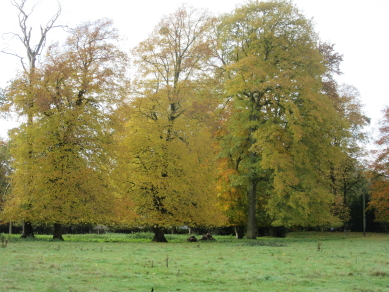
Monday – Leominster – The depression is taking a long time to move away and the pressure remains very low. The skies are grey and whilst it is not raining at the moment everywhere is saturated. Leaves are turning yellow, red, gold and bronze and falling in ever increasing quantities. Up Ryelands road and onto the path that was once Cockcroft Lane. In the paddock of Ryelands House, a cock Ring-neck Pheasant stands on a tree stump picking at the rotting core. The sun comes out, brightening the land which glistens damply. A fallen tree still lays across the path. The large field to the east of the path has been ploughed and harrowed. There appears to be strips of seedlings set quite some distance apart. Root crops, a beet of some sort, are scattered on the soil where they have been missed by the harvester. A pair of Wood Pigeons and another of Stock Doves feed further down the field. A flock of Jackdaws and Carrion Crows feed on the next field southwards.
Along Southern Avenue past the industrial estates and into the Worcester Road. On along the new path from the White Lion Inn to the orchard. Cider apples lay rotting on the ground. Sadly my back is still too fragile to consider either collecting them or processing them.
Friday – Leominster – A quick detour on the way to the station to look at the River Lugg. The path to Butts Bridge is the thickly strewn with fallen Ash tree leaves. The river is actually slightly lower than earlier in the week despite overnight rain. The other parts of the country flooding is causing chaos. In Sheffield people are trapped in Meadowhall, not very fondly known as Meadowhell, because the surrounding roads are underwater. Long lines of fluffy clouds stretch across a blue sky.
Fields to the south of Dinmore Hill are flooded. Brown maize stands in deep water. Lesser Black-backed Gulls float on the flood. South of Hereford my first flocks of the season of winter thrushes fly over the fields.
Abergavenny – From near the station a path runs through a small group of bungalows then picks up a track. This joins Coed Glas Lane beside a large new development of houses. This road joins the B4233. The road rises passing Keepers Lodge, an early 20th century building. All other houses here are much newer. A Common Buzzard glides over head. A large Victorian house is boarded up. Pen-y-fal Chapel is under scaffolding. It is in the process of being converted into nine residences. Back down the road into Lower Monk Street to the town centre. Over the River Gavenny.
Into Monk Street, the A40. A cinema is now an evangelical Church. Originally built in the late 1920s as The Pavilion to undermine a plan by Gaumont Cinemas to open a cinema. It closed a few years later. It was modernised in 1935 and painted “Marina Blue” to celebrate the wedding of the Duke of Kent and Princess Marina. It closed as a cinema in the late 1960s. The base of a late 15th century preaching cross stands on a lawn next to St Mary’s Priory church.
St Mary’s Priory was founded in 1087 by Hamelin de Ballon, lord of Northern Gwent. The monastery had a prior and twelve monks from the Abbey of St Vincent in Le Mans. The priory lay outside the walls of Abergavenny. Little remains of that institution and the present church dates from the 14th century, commissioned by John de Hastings, Lord of Abergavenny. Most of the priory was demolished after the Reformation. St Mary’s is a large church. There are a good number of monuments including a wooden  carved figure of Sir John de Hastings. An important tomb is that of Sir William ap Thomas and his wife Gwladys. Sir William was the son of Thomas ap Gwilym Jenkin and Maud Morley of Llansantffraed. He was patriarch of a number of important dynasties including the Earls of Powis, Pembroke and Caernarvon. Gwladys was the widow of Sir Richard Vaughan who with his father-in-law, Davy Gam, fought at Agincourt. She was known as “The Star of Gavenny” and when she died in 1454 over 3000 people attended the funeral. Another fine monument is to Sir Richard Herbert of Ewyas. In St Joseph’s chapel is an extraordinary sculpture, the “Jesse Figure”. It would have been part of an elaborate construction showing the lineage of Jesus from Jesse, father of King David. These are often found in stained glass but this wooden one is probably unique now. It is carved from a single piece of Oak and would once have been brightly painted. There are a number of other monuments around the church dating from the 15th century onwards. The monastic choir stalls are magnificently carved. A royal crest is inscribed “Charles Morgan 1709 Edward Waters”. The glass is mainly Victorian but with some fine modern pieces. There is a ring of ten bells, recast in 1948. Four date from the 14th century, two from the Restoration, two celebrating Queen Victoria’s Golden Jubilee and two from 1948.
carved figure of Sir John de Hastings. An important tomb is that of Sir William ap Thomas and his wife Gwladys. Sir William was the son of Thomas ap Gwilym Jenkin and Maud Morley of Llansantffraed. He was patriarch of a number of important dynasties including the Earls of Powis, Pembroke and Caernarvon. Gwladys was the widow of Sir Richard Vaughan who with his father-in-law, Davy Gam, fought at Agincourt. She was known as “The Star of Gavenny” and when she died in 1454 over 3000 people attended the funeral. Another fine monument is to Sir Richard Herbert of Ewyas. In St Joseph’s chapel is an extraordinary sculpture, the “Jesse Figure”. It would have been part of an elaborate construction showing the lineage of Jesus from Jesse, father of King David. These are often found in stained glass but this wooden one is probably unique now. It is carved from a single piece of Oak and would once have been brightly painted. There are a number of other monuments around the church dating from the 15th century onwards. The monastic choir stalls are magnificently carved. A royal crest is inscribed “Charles Morgan 1709 Edward Waters”. The glass is mainly Victorian but with some fine modern pieces. There is a ring of ten bells, recast in 1948. Four date from the 14th century, two from the Restoration, two celebrating Queen Victoria’s Golden Jubilee and two from 1948.
Next to the church is the 14th century Tithe Barn on a 12th century site. By the tithe Barn is a large brick building with decorated freeze and roundels now a solicitors office. Into the High Street then down past the Tan House to the Castle Meadows. On to the eastern side of the meadows where there is an oxbow lake. A foot bridge crosses the Gavenny. Back to the path that runs alongside the River Usk, Afon Wysg. A single head of Tansy, little yellow buttons, is still in flower. Eight cattle are on the meadows. A pair of dogs bounce up to one cow but then think better of it. Magpies are standing on another cow’s back. The water level in the river is not particularly high but it has clearly flowed strongly at some point as nearly all the debris that normally is trapped under the arches of the bridge has gone with the exception of a large tree trunk and branches which stretches across two of the arches.
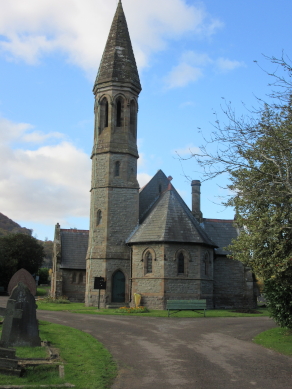
Over the river then through the stanchions of the former railway bridge which leads to Llanfoist, Llan-ffwyst cemetery. The Victorian cemetery keepers house stands just beyond, it looks abandoned. Part of the wall of the cemetery has fallen by a small gate porch which is locked. The main vehicle entrance however is open although the steps up to the chapel are barred as they are twisted and collapsing. The cemetery opened in 1894. The small chapel is open. It has an octagonal tower and a hexagonal apse and contains a wooden altar, couple of choir stalls along with pews. A piano and bier stand in the aisle. There are also a good number of Calor gas heaters! The chapel was mothballed for many years before being restored and opened again by a group of volunteers. In a corner of the extensive graveyard are couple of Indian graves, one being a war grave. Blorenge towers over the graveyard.
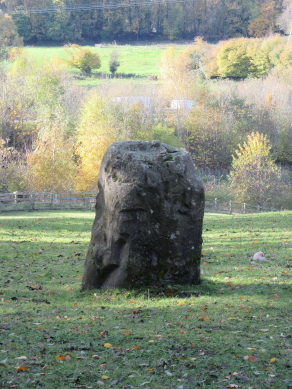
At the far end of the graveyard are allotments. Just beyond the allotments is a standing stone, about which I can find nothing! A footpath leads down to a tunnel under the Head of the Valleys road. Further up the valley is a very large pink farmhouse, Pen-y-Worlod. On the other side of the tunnel underneath the Head of the Valleys road is a large white house, Evesham House, and a garden centre. On the other side of the lane, Church Lane, there is a wooded tump. Unlike the standing stone, this is marked on the OS map but there is no other information. From its position, it could be a simple Norman motte for a small wooden fort. A bubbling stream rushes down the side of the road. Past the village hall and recreation ground of Llanfoist. The lane comes out at Llanfoist crossing car park. Through the village. St Faith’s parish hall is of corrugated iron, a tin tabernacle. Most of the houses are modern.
Back across the Usk Bridge. A ginnel runs up to the town. The old steps show signs of wear, dipping in the middle where have feet have worn them over the years. There are several Victorian cottages in the street, Cae Pen y Dre, at the top of the steps, one is dated 1883, other houses are modern. Into Union Road East. Here “Blorenge View” is dated 1881. Into Merthyr Road. Abergavenny steam laundry is dated 1897 on a worn stone portico. It is of course no longer a laundry. the area is mainly working class terraces from the Victorian era with the occasional larger house. Into Frogmore Street and the shopping area. In Baker Street stands an independent cinema. Through the town back to the station. Route
Saturday – Home – A sharp frost has had an effect on the great Horse Chestnut which towers above our garden from next door. Leaves are falling at an extraordinary rate, a copper snowstorm. Real snow has been falling to the west. The tree-man is taking out an unwanted Goat Willow which is crowding other trees, including the Marjorie Pippin plum. He has also removed a large spreading Leylandii and coppiced a Hazel which I cut some ten years ago but has grown back too strongly! The area at the bottom of the garden looks much more open now. Two of the old pears in the front part of the garden have been cut back too.
Sunday – Leominster – A cool damp morning but bright. High scattered cloud leaves some blue sky. Starlings chatter on the rooftops. It is cool enough for a light sheen of ice on the railway bridge. The water level in the River Lugg remains high. New mole hills have been thrown up along the riverside path. Blue and Great Tits flit through the bushes. The last flowering Hogweeds are turning to seed. The market is smaller now but with much more Christmas stuff. The Kenwater continues to flow rapidly. Round to the Pinsley Mead to take pictures of where a bridge once stood. Up through the churchyard, the minster bells start tolling. Smartly dressed scouts head for the church and the Remembrance Sunday parade.
Thursday – Leominster – Another front moves through from the west bringing a night of rain which continues into the morning. A brisk wind makes it cold too. There is extensive flooding around the country again with the Doncaster area being badly affected. Parts of Hereford near the Grey Friars area are also suffering. Down to the railway bridge. A small flock of gulls flies over slowly twisting and turning and drifting in the wind. A single Fieldfare flies through the flock. The water level in the River 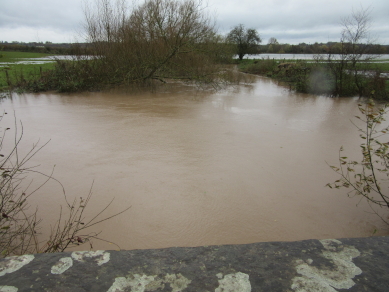 Lugg has risen yet again, the water rushing down a rich milky red-brown as tons of soil are wasted and swept away.
Lugg has risen yet again, the water rushing down a rich milky red-brown as tons of soil are wasted and swept away.
Along the Worcester Road to the Leominster Enterprise Park, industrial estate being a too working class term these days. The small drainage ditch that runs through the park and along the eastern end is flowing rapidly and full. Along the Hereford Road and the footpath past Broadward farm. Cattle are in the sheds and a group is gathered around the feeding hopper. Three female Common Pheasants take flight from gleaning spilt cattle feed. A field of sunflowers is yet to be harvested. To the south are flooded fields. A large flock of winter thrushes moves around the bushes at the edge of these fields. Back to the Hereford Road and down to Broadward Bridge. The overflowing River Arrow flows under the bridge and floods out again into the fields.
Friday – St Albans – I have a slightly convoluted journey to reach the Worcester bypass because the A44 is closed by flooding by the Teme. Around Worcester the River Severn has also overflowed covering miles and miles of fields. Earth moving equipment building the extension to the bypass stands on earth islands in the middle of a vast lake. The M5 onto the M42 down the M40. In Oxfordshire the River Cherwell has also flooded extensively. Around the M25 and into St Albans. Find my hotel car park on the second attempt. Across the road and into the cathedral.
St Alban is declared to be the first British Christian martyr. He was beheaded around 250-300CE for sheltering a Christian priest. A shrine seems to have become established later in the 4th century. Bede mentions a church and Gildas a shrine. Bishop Germanus of Auxerre visited in 429. The 13th century chronicler Matthew Paris 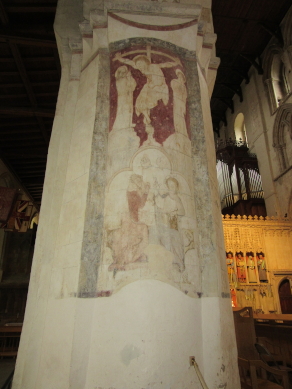 claimed that the Saxons destroyed the building in 586. Offa II of Mercia, is said to have founded a Benedictine monastery at St Albans in 793 on Holmhurst Hill, now Holywell Hill. This abbey was probably sacked by the Danes around 890 and the office of abbot remained empty from around 920 until the 970s when the efforts of Dunstan reached the town. In 1005, Abbot Ealdred was licensed to remove building material from Verulamium, the Roman town on the plain below Holywell Hill. However, attempts to rebuild were hampered by Viking raids. Much of the current layout and proportions of the structure date from the first Norman abbot, Paul of Caen (1077-1093), the 14th abbot. He was appointed by his uncle, the new Archbishop of Canterbury, Lanfranc. The cruciform abbey was the largest built in England at that time, it had a chancel of four bays, a transept containing seven apses, and a nave of ten bays – fifteen bays long. The tower is the only 11th century great crossing tower still standing in England.
claimed that the Saxons destroyed the building in 586. Offa II of Mercia, is said to have founded a Benedictine monastery at St Albans in 793 on Holmhurst Hill, now Holywell Hill. This abbey was probably sacked by the Danes around 890 and the office of abbot remained empty from around 920 until the 970s when the efforts of Dunstan reached the town. In 1005, Abbot Ealdred was licensed to remove building material from Verulamium, the Roman town on the plain below Holywell Hill. However, attempts to rebuild were hampered by Viking raids. Much of the current layout and proportions of the structure date from the first Norman abbot, Paul of Caen (1077-1093), the 14th abbot. He was appointed by his uncle, the new Archbishop of Canterbury, Lanfranc. The cruciform abbey was the largest built in England at that time, it had a chancel of four bays, a transept containing seven apses, and a nave of ten bays – fifteen bays long. The tower is the only 11th century great crossing tower still standing in England.  The monastic abbey was completed in 1089 but not consecrated until Holy Innocents’ Day, 28th December 1115, by the Archbishop of Rouen. King Henry I attended as did many bishops and nobles.
The monastic abbey was completed in 1089 but not consecrated until Holy Innocents’ Day, 28th December 1115, by the Archbishop of Rouen. King Henry I attended as did many bishops and nobles.
A large reception and café have been added to the south transept. The quire is richly carved wood, designed in 1903 by John Oldrid Scott. In the north transept is a fine wall painting of the “Doubting of Thomas” from around 1400 and discovered under whitewash in 1846. A large brass of Abbot Thomas de la Mare, made in Flanders is in the north presbytery aisle. Further on is the shrine of St Alban. Nearby is the chantry of Humphrey, Duke of Gloucester, son of Henry IV, who died in 1447. The grave is in a tiny chapel visible through a grating in the floor beside St Alban’s shrine. The nave is the longest in Great Britain. Few monuments adorn the walls which adds to the mediaeval feel of the building. The nave screen contains modern statues sculpted by Rory Young. On the pillars of the nave are wonderful mediaeval wall paintings, some dating from 1200. These were covered in whitewash during the Reformation and not found again until 1862. The cathedral is very busy, lots of school children, so I spend less time than it deserves. Bells ringing out at midday.
Outside, I pass by an open parkland next to the cathedral, the site of the monastery, to the Abbey Gate. It was built in 1365 and is the last remaining building (except for the Abbey itself) of monastery. It was besieged during the Peasants’ Revolt in 1381, and was used as a prison following the dissolution of the Abbey in 1539. From 1479, the third printing press in England was housed here. Since 1871 it has been a part of St Albans School.
Down Abbey Mill Lane. Past Abbeygate House, a plain but well proportioned Georgian building. Further down the hill are terraces of cottages. At the foot of the hill is Ye Olde Fighting Cocks pub which was originally built as a mediaeval Pigeon House around 1403. It was erected here as a house in 1600 on the site of St Germain’s gate to monastery. In the 17th and 18th century the inn became the local centre for cock fighting but renamed was The Fisherman when the sport became illegal in 1849. Like many other places it is reputedly the oldest public house in Britain. And of course Oliver Cromwell stopped here.
Beyond is the River Ver. This is a rare type of river being fed from an underground aquifer. There are only about 200 similar rivers in the world. It formed an important part of the watercress industry which flourished in the 19th and early 20th centuries. Over footbridge is Verulamium Park. There are the remains of the Roman city that stood here, although much remains unexcavated underground. A large ornamental lake stands on this side of the park on the site of the monastery fish ponds. Mute Swans, Coots and Mallard are on the lake. A Black-headed Gull suddenly comes around an island chasing a Shoveler.
Up to St Germain Block, large section of Roman wall. Much of the visible stone of the town was robbed out to build the abbey. This section of wall was probably saved because it formed part of the enclosure of the 12th century St Germain’s chapel. Back to the path from and up to the London Gate. There were four large gates at the points where major roads entered the town. The London Gate stood across Watling Street on its route from Dover to Chester via London. Other gates spanned the roads which linked to Colchester and 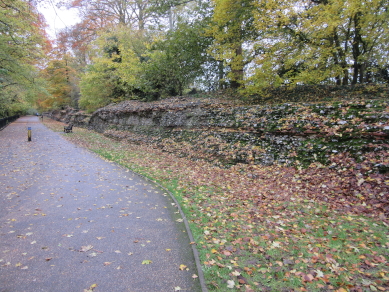 Silchester making Verulamium very well connected with the rest of Roman Britain. The foundations of the London Gate were excavated by Mortimer and Tessa Wheeler in the 1930s. The foundations are massive but have now been largely reburied. The path continues. Beside it is a long stretch of the town walls. They were built in the late 3rd century and were almost 2 miles long and 7 feet thick, built of flint and lime mortar with tile courses of brick tiles running through them. Verulamium was surrounded on three sides by ditches originally these have been over 20 metres wide and 8 metres deep, part of the defences of the earlier Iron Age settlement Velamiom. This was a major town established by the Catuvellauni. In 61CE Boudicca of the Iceni tribe led the famous rebellion against the Romans destroying both Colchester and London before reaching Velamion which was raise to the ground. Verulamium rose from the ashes of this town. A footbridge crosses the very deep Iron Age ditch.
Silchester making Verulamium very well connected with the rest of Roman Britain. The foundations of the London Gate were excavated by Mortimer and Tessa Wheeler in the 1930s. The foundations are massive but have now been largely reburied. The path continues. Beside it is a long stretch of the town walls. They were built in the late 3rd century and were almost 2 miles long and 7 feet thick, built of flint and lime mortar with tile courses of brick tiles running through them. Verulamium was surrounded on three sides by ditches originally these have been over 20 metres wide and 8 metres deep, part of the defences of the earlier Iron Age settlement Velamiom. This was a major town established by the Catuvellauni. In 61CE Boudicca of the Iceni tribe led the famous rebellion against the Romans destroying both Colchester and London before reaching Velamion which was raise to the ground. Verulamium rose from the ashes of this town. A footbridge crosses the very deep Iron Age ditch.
Out of the park and on to King Harry Lane. The housing here ranges across various decades of the 20th century. Many want to be arts and crafts houses but are more modern. There are a few late Victorian villas around and an ornate Victorian lodge house on the site of a Roman cemetery. On towards the town centre where the houses are 1930s with just a hint of art deco about. These houses are built very large square, although not completed until the 1960s, enclosing a recreation ground. This area is St Stephens. King Harry Lane comes to a road junction St Stephen’s Hill meets Watling Street. On the junction is St Stephens church. Also here is St Stepans (sic) House, built in the early 18th century, a short 18th century terrace and across the junction, the again 18th century King Harry public house.
St Stephen with St Julian’s church was founded in 948 by Abbot Ulsinuus of St Albans. Straight across from the church door is an octagonal stone font which some have dated to 1350. It has eight figures around the stem. Most have their faces obliterated, probably during the Civil War. Behind the font in the North wall is an  incomplete window to believe to be early Norman or late Saxon which was only found in 1934. The pulpit is in oak, made in 1936. A brass lectern was looted from Holyrood Palace in 1544 by Sir Richard Lee. He presented it to this church but during disturbances the lectern was buried in the Mortimer vault in the chancel and it was not discovered for another 200 years. In 1984 the church was broken into and the lectern removed taken to Scotland. It can be argued this was not theft as it was already been looted in 1544. The present lectern is a replica of the original. The Lady Chapel was added in 1220.
incomplete window to believe to be early Norman or late Saxon which was only found in 1934. The pulpit is in oak, made in 1936. A brass lectern was looted from Holyrood Palace in 1544 by Sir Richard Lee. He presented it to this church but during disturbances the lectern was buried in the Mortimer vault in the chancel and it was not discovered for another 200 years. In 1984 the church was broken into and the lectern removed taken to Scotland. It can be argued this was not theft as it was already been looted in 1544. The present lectern is a replica of the original. The Lady Chapel was added in 1220.
Down Saint Stephen’s Hill. Another lodge house, this to Westminster Lodge and dated 1873, is now a vets. The sky is getting darker and darker and the wind brisker. St Albans Abbey station is a single track terminus, the line running from Watford. It was the first railway station in St Albans, built by the London and North Western Railway in 1858. The company’s plans to extend northwards to Luton and Dunstable never materialised. The Midland Railway opened their station (St Albans City) in 1868. at the end of the 19th century, the station was eight tracks across with a turntable near the road. Now there is the single platform and track. A bridge crosses the River Ver. Beyond are large covered reservoirs and the offices of St Albans Waterworks Company built in 1908. Road climbs Holywell Hill past Spencer Place. On the hill stood Holywell House, a favourite residence of the Duke of Marlborough (1652-1720) and his wife Sarah Churchill. To the south east of the house was the holy well, now built over. On up the hill. The houses have some age here. Many look 18th century but probably with earlier cores. A number are former pubs, The Trumpet, The Saracen’s Head etc. Many of the shops are small independent businesses. The Comfort Hotel was originally built in 1911 by Samuel Ryder. Samuel Ryder was also Mayor of St Albans in 1905-6 and many buildings in the town are dedicated to him or by him. In 1908, after a spell of ill-health, he took up golf and played at nearby Verulam Golf Course. During the next few years he encouraged team competitions, locally at first. Then, during 1927, the first Ryder Cup match was played between Great Britain and America, with the prize, a magnificent gold cup manufactured by Mappin and Webb and worth about 100 guineas, having been donated by Samuel Ryder.
Into High Street and then French Row where there is the clock tower. It is a secular belfry built between 1403-1412 containing a large curfew clock dating from 1335. French row was occupied by the Dauphin’s troops in 1216. King John of France was detained in the Fleur-de-lis for a time in 1356. Near this site stood the Eleanor Cross where the body of Queen Eleanor rested one night on its progress from Harby to Westminster 13th December 1290. Beside the marketplace is the Corn Exchange erected in 1857, now a jewellers. The Baptist Church, built in 1885, stands in Dagwall Street.
Up to the top of the hill. The Museum and Art Gallery, in the former Town Hall built in the classical style in 1826 by George Smith, is at the head of a wide boulevard. Shops here are mainly chain stores. Buildings are a mixture of Victorian and early to mid-twentieth century. A classic 1920s post office is still operating. I pause for a pint (with Grateful Dead on the sound system) then head up further on up the hill past the War Memorial. The boulevard comes to an end at St Peter’s church which unfortunately is locked. This is another church believed, based upon the writing of Matthew Paris, to have been founded in AD 948 by Abbot Ulsinus of St Albans. The stone church is 13th century in origin. In 1893, after he had completed his restoration of the Cathedral and Abbey Church, Lord Grimthorpe took it upon himself to restore St Peter’s at his own expense. He lengthened the chancel and the nave by one bay each. He also widened the church by demolishing the north wall of the nave and building a new north wall outside the line of the old one.
Opposite are Pemberton almshouses founded in 1627 by Roger Pemberton, the High Sheriff. Legend says the almshouses were founded to atone for an accident when he killed a widow with a bow and arrow. At the top of the gate is a metal arrowhead. Nearby is an early 18th century house built by Edward Strong (chief mason under Sir Christopher Wren at St Pauls Cathedral) for his own use. It was formerly known as Electricity House. Another large was designed in 1829 by George Smith, architect of the Town Hall.
Back down the hill. The shops are still a mixture Georgian to early 20th century. One old premises is narrow building between two early 20th century buildings, formerly The Bat and Ball, still named in stone on the portico, now a beauty shop.
My lodgings, White Hart hotel was built circa 1470. Simon Fraser, 11th Lord Lovat, was the last aristocrat to be beheaded in England. He stayed in this building on his way to Tower Hill to meet his fate in 1747.
Saturday – St Albans – Overhead is clear and the moon is bright in the blue morning sky. However there is a thick cloud to the west. Out of the hotel and down Pageant Road, a mixture of early and late 20th century terraces. At the end of the road is the White Hart pub, far older than the street, and a gents hairdressers in a little extension to a house. It is before eight in the morning and although the hairdressers says closed someone getting a haircut. Old London Road heads west. Here the houses are a mixture of Georgian and mid 20th century. I head up Watson’s Walk. A residence called the “Old Factory” is dated 1926 and has a vaguely art deco look. The street ends on the London Road. Houses are a mixture of a wide range of dates the Farmer’s Boy pub looks older than most. Restaurant declares itself as modern French Asian dining. The Odyssey is a classic 1930s cinema and still operating as such. A strange looking pair of Victorian Gothick houses are faced in flint. They are early 19th century and probably by George Smith.
Up Alma Road. The houses are 19th century with modern infill. A large Victorian school of 1882 is now a playschool nursery. At the junction with Victoria Street stands the Trinity United Reformed church. It has an ornate tower with a clock which actually shows the correct time. The foundation stone is dated 1902. On the corner of Beaconsfield Road is a shop in a Victorian building that looks like a former pub. Aa short distance up Beaconsfield Road is the Catholic church of SS Alban and Stephen. The main building dates from 1904 but it has been added to over the years, the last major addition of aisles in 1966.
Back to Victoria Street and up to the railway station a bridge crosses the line. It was built by the Midland Railway in 1868 on its extension to St Pancras. The station is wholly modern. On the edge of the bridge is a small building raised up from the station area below, now a beauty shop. Back down Victoria Street. One side of the street is mainly housing late 19th century, the other is largely early 20th century and more modern shops. The junction with Upper Lattimore Road stands a large 1930s building on the site of the 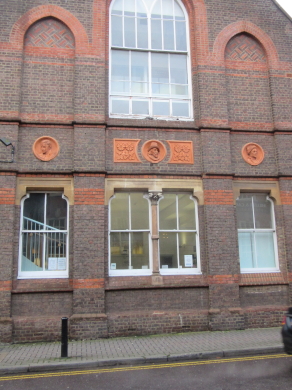 lodge to Marlborough House, now a college. Opposite is a Victorian pub.
lodge to Marlborough House, now a college. Opposite is a Victorian pub.
The Methodist Church, which opened on 30th June 1898, stands in Marlborough Road. The architects were Messrs Gordon, Lowther and Gunton of London and the work was carried out by Ezra Dunham, a local builder and one of the Trustees of the Chapel. The Maltings is a modern multi-storey car park and shopping mall on the site of St Albans Brewery. Back in Victoria Street, a Baptist church of 1880 is now a nightclub. An old boarded up house is attached to the Baptist church and then abuts onto a modern building. Opposite the Maltings shopping centre is a small garden, a former burial ground of the Society of Friends. A short distance up the street are two early 18th century cottages. Opposite is a Salvation Army citadel of 1911. This is followed by several large Victorian buildings. One, the former Free Library, has plaques in red clay on the wall depicting Davey, Bacon and Hogarth. Opposite is a later public library built in 1910 on the site of St Peter’s Brewery. Victoria Street ends at Chequer Street opposite the art gallery and museum. An early 20th century building on the corner is on the site of the Castle Inn before which Edmund Beaufort, 2nd Duke of Somerset was slain during the first battle of St Albans on 22nd May 1455. The battle traditionally marks the beginning of the Wars of the Roses. Richard, Duke of York, and his allies, the Neville earls of Salisbury and Warwick, defeated a royal army commanded by Beaufort. A market is set up in St Peter’s Street, the wide boulevard leading to St Peter’s church. The market is huge by Hereford standards, stretching all the way up to the church and back down Market Place.
Sunday – Leominster – It is is a grey cold very damp morning. A gauzy mist hangs over the town. A robin sings bravely by the railway bridge. More Robins sing rather more fitfully on the far side of the bridge and by the river. The water level in the River Lugg remains much the same as in earlier in the week. Easters Meadow has been mown, tractor tyre marks have sunk into the swampy ground. Siskin, Blue and Great Tits are active in the trees along the river bank. The depth of water at the confluence of the Lugg and Kenwater is enough to smooth out the ripples over the weir. The market is much smaller, which is hardly surprising given the weather. Back along Mill Street. The recently cleared path shows how how paths become overgrown. All along the edge of the path leaf litter has built up. This will rot down and plants will take over, building up the loam. In following years the leaf litter will steadily move out across the path.
Wednesday – Bodenham Lake – Despite a couple of rain free days the fields the south of Leominster and along the Bodenham road are still flooded albeit at a lower level. Along the track from the car park. Fieldfares are chattering in the orchard beyond the hedgerow. A Redwing watches from a bush. More Redwings, Blue Tits and Goldfinches are in the bushes close to the lake. The water level is very high, almost flowing over to the path and indeed the pools of water show that it is been higher recently. A few Canada Geese and Mallard swim out on the water. Chaffinches flit down the orchard hedge. A Common Buzzard circles low over the meadow.
Two cock Ring-necked Pheasants cross the grass in front of the hide; a Jay flies away. A Moorhen stalks sodden rushes laying flattened on the water. A few stalks of dead Purple Loosestrife sticking above the water are all that can be seen of the scrape. The lake here seems completely devoid of wildfowl. I scan and find a few Mallard on the southern side and just two Cormorants in the trees. Coppery-brown speckles on the far side reveals more cock Ring-necked Pheasants. A Coot is calling from behind the island.
The path is a beautiful mixture of yellow and silver, either sides of the Alder leaves. Back in the meadow where are pheasants everywhere crashing through the undergrowth beneath the hedgerows in attempt to get through the fence to escape from me. Blackbirds chunter above. Sky is covered in cloud and there is a cold wind. Sheep are in the cider orchard chomping up the hundreds of apples which the Trust declared they were going to collect to sell for funds, they are all rotting.
Friday – Leominster – Another night of rain is followed by a cool but sunny morning. However, clouds are building again in the West. Down the street. Overhead a Jackdaw and Magpie squabble as they fly past. Over the railway to Butts Bridge. The water level in the River Lugg has fallen considerably. It flows fast and grey. A Mistle Thrush rasps. Redwings, Blue Tits and Goldfinches move through the riverside bushes. Along Worcester Road to the old A44 bridge. Wood Pigeons sit silently in the trees by the railway. A pair of Jackdaws sit watching from a mobile mast, whilst another half dozen are flying about, calling. The sky is clouding over rapidly now.
On the other side of the A49 there is a pear tree at the junction of the abandoned road and the A44. The ground under the tree is covered in huge pears. I collect seven, which makes my bag quite heavy enough. Past West Eaton and up Widgeon Meadow to the old drovers steps. Small dark chocolate toadstools grow on the steps. The slope above steps is slippery with mud. Blue Tits feed in the bushes. 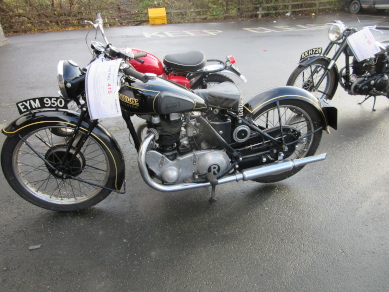 Blackbirds and Redwings are flighty at the tops of the taller bushes. Up the old hollow way towards the top of Eaton Hill. Small yellow crab apples cover the ground. Along the hilltop, past the solar farm and down the track. Most trees have lost their leaves now now just a few Field Maples still carry bright yellow leaves and oaks have thick mid-brown clusters. Towards the bottom of the hill to young Beeches are a glorious orange-copper colour. A Sweet Chestnut is still pale green. Two Mute Swans fly over with thrumming wings.
Blackbirds and Redwings are flighty at the tops of the taller bushes. Up the old hollow way towards the top of Eaton Hill. Small yellow crab apples cover the ground. Along the hilltop, past the solar farm and down the track. Most trees have lost their leaves now now just a few Field Maples still carry bright yellow leaves and oaks have thick mid-brown clusters. Towards the bottom of the hill to young Beeches are a glorious orange-copper colour. A Sweet Chestnut is still pale green. Two Mute Swans fly over with thrumming wings.
In Brightwells’ yard there are a number fine motorbikes three BSAs,(a C11, C15 and a Gold Star), a Rudge Ulster, Honda CA77 and Francis Barnett Light Cruiser. An RAC rally was held yesterday and large motor sports lorries are loaded and waiting departure. The water level in the River Kenwater has also fallen but it is still flowing rapidly.
Sunday – Leominster – A grey, misty, very damp morning but not particularly cold. A few House Sparrows chirp and a Blackbird in the distance starts to sing then gives up. Jackdaws and Wood Pigeons on the roof tops and television aerials sit silently. The water level in the River Lugg has changed little, still several feet below its highest point a couple of weeks ago. A Robin sings on the far side of Butts Bridge. Blue Tits chatter as they flit through the riverside trees. In the top branches, Jackdaws and Carrion Crows stand hunched like brooding sentinels. At the confluence of the Lugg and Kenwater a Cormorant flaps out of the water and flies off downstream. Cormorants always seemed to me to be true heirs of pterodactyls, although I doubt there is any meaningful connection.
The market is small. I realise several regular traders are missing, the meat lorry has not been here for many weeks now, the work-shoe chap is also absent and only one plant seller is here now. Cheaton Brook flows red as it enters into the grey Lugg. Across Bridge Street car park. A Jackdaw flies over constantly calling a stream of various chacks, squeaks and other strange noises. It lands in the tree high above the Kenwater. Another Jackdaw then flies in the same direction also calling to join it. Were the calls “follow me, follow me” and “I’m coming, I’m coming” – who knows? Blackbirds are squabbling at the top of the riverbank. A Pied Wagtail flies up to the roof of the fire station.
Wednesday – Leominster – The fields south of Leominster remain under water. The River Arrow at Broadward Bridge is still brimming full. Water lays on the meadows along the Gloucester road. The lane to Bodenham is still full of puddles and deeper water near the junction.
Bodenham Lake – The sky is uniform grey, the air very wet. Various birds twitter and squeak. Chaffinches fly up into the bushes. The creamy red fruits of Spindle are still on the tree although most the leaves have fallen. Hedgerow is still spotted red with hips. The skin on many has burst open exposing the soft core. A good number of Canada Geese sail slowly across the water of the lake. A rey Heron stands on one of the only branches on the new islets created by the removal of the long wooded spit. Three young Blackbirds and a Green Woodpecker are on the meadow. The Blackbirds are almost black but do not possess the shiny sable of an adult and their beaks have yet to become yellow.
The water level in the lake has barely dropped over the week. Canada Geese are scattered all around. Squabbles break out into noisy shouting matches then subside. A small group of Mandarin Duck, the males in full breeding plumage, now disappear behind the island. Several Common Pheasants are scattered around the edges of the lake. Autumn colours are rapidly disappearing from Dinmore Woods as the 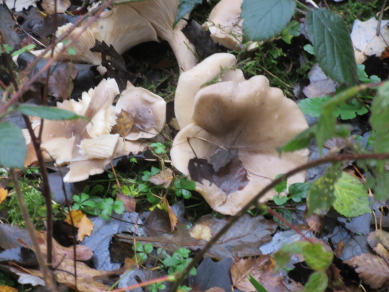 Gtrees turn winter grey. Cloud sits on top of the uppermost trees. A donkey bellows starting all the Canada Geese cackling loudly. A pair of Mallard appear near the island but there appears to be no winter duck present or Cormorants.
Gtrees turn winter grey. Cloud sits on top of the uppermost trees. A donkey bellows starting all the Canada Geese cackling loudly. A pair of Mallard appear near the island but there appears to be no winter duck present or Cormorants.
The path through the Alder plantation is a quagmire. A large troop of fungi is in the undergrowth, probably Clouded Funnel, Clitocybe nebularis. Fieldfares call as they fly around the orchards. Dessert apples are now down to the last few. I gather some, the ones that are not bruised or bird pecked but are still rather scabby. However, they peel and then taste fine.
Newtown – The road is up again at the bottom of Bargates and there is a queue of traffic back to Morrisons. So after shopping I turn out of town, the queue now being back to the Conop Garage. A little way down the Brecon road is a turning to Newtown. The lane is narrow and fortunately nothing approaches from the other direction. There are a few puddles but just before the junction onto the Ivington road at Newtown there is a deep flood. Water waves up towards the car bonnet and I make sure I keep the engine revving, stalling here might be a minor disaster. However, no problems and I return down Ryelands Road to the town having avoided the long delay.
Thursday – Home – The weather is dry at the moment and there is an appearance by the sun. The chicken run is a disgusting swamp so despite my still fragile back I dig it out. There are worms everywhere. Many go with removed mud, some of which is piled around the rhubarb patch and the rest on a vegetable bed where it soon attracts the attention of a Robin. The hens make short work of the worms left exposed in the run. I leave them for a while to make the most of their protein bonus and fill the bird feeders. Whilst doing so, a Robin flies inside the summerhouse and, as usual, shows their remarkable stupidity failing to find the wide open door as I try to shoo it out. I then strew a bale of bedding across the chicken run and leave the girls happily scratching away.